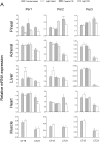Effects of nocturnal light on (clock) gene expression in peripheral organs: a role for the autonomic innervation of the liver
- PMID: 19478857
- PMCID: PMC2682563
- DOI: 10.1371/journal.pone.0005650
Effects of nocturnal light on (clock) gene expression in peripheral organs: a role for the autonomic innervation of the liver
Abstract
Background: The biological clock, located in the hypothalamic suprachiasmatic nucleus (SCN), controls the daily rhythms in physiology and behavior. Early studies demonstrated that light exposure not only affects the phase of the SCN but also the functional activity of peripheral organs. More recently it was shown that the same light stimulus induces immediate changes in clock gene expression in the pineal and adrenal, suggesting a role of peripheral clocks in the organ-specific output. In the present study, we further investigated the immediate effect of nocturnal light exposure on clock genes and metabolism-related genes in different organs of the rat. In addition, we investigated the role of the autonomic nervous system as a possible output pathway of the SCN to modify the activity of the liver after light exposure.
Methodology and principal findings: First, we demonstrated that light, applied at different circadian times, affects clock gene expression in a different manner, depending on the time of day and the organ. However, the changes in clock gene expression did not correlate in a consistent manner with those of the output genes (i.e., genes involved in the functional output of an organ). Then, by selectively removing the autonomic innervation to the liver, we demonstrated that light affects liver gene expression not only via the hormonal pathway but also via the autonomic input.
Conclusion: Nocturnal light immediately affects peripheral clock gene expression but without a clear correlation with organ-specific output genes, raising the question whether the peripheral clock plays a "decisive" role in the immediate (functional) response of an organ to nocturnal light exposure. Interestingly, the autonomic innervation of the liver is essential to transmit the light information from the SCN, indicating that the autonomic nervous system is an important gateway for the SCN to cause an immediate resetting of peripheral physiology after phase-shift inducing light exposures.
Conflict of interest statement
Figures




References
-
- Weaver DR. The suprachiasmatic nucleus: a 25-year retrospective. J Biol Rhythms. 1998;13:100–112. - PubMed
-
- Bos NP, Mirmiran M. Circadian rhythms in spontaneous neuronal discharges of the cultured suprachiasmatic nucleus. Brain Res. 1990;511:158–162. - PubMed
-
- Green DJ, Gillette R. Circadian rhythm of firing rate recorded from single cells in the rat suprachiasmatic brain slice. Brain Res. 1982;245:198–200. - PubMed
-
- Buijs RM, Hermes MH, Kalsbeek A. The suprachiasmatic nucleus-paraventricular nucleus interactions: a bridge to the neuroendocrine and autonomic nervous system. Prog Brain Res. 1998;119:365–382. - PubMed
-
- de la Iglesia HO, Blaustein JD, Bittman EL. The suprachiasmatic area in the female hamster projects to neurons containing estrogen receptors and GnRH. Neuroreport. 1995;6:1715–1722. - PubMed
MeSH terms
Substances
LinkOut - more resources
Full Text Sources

